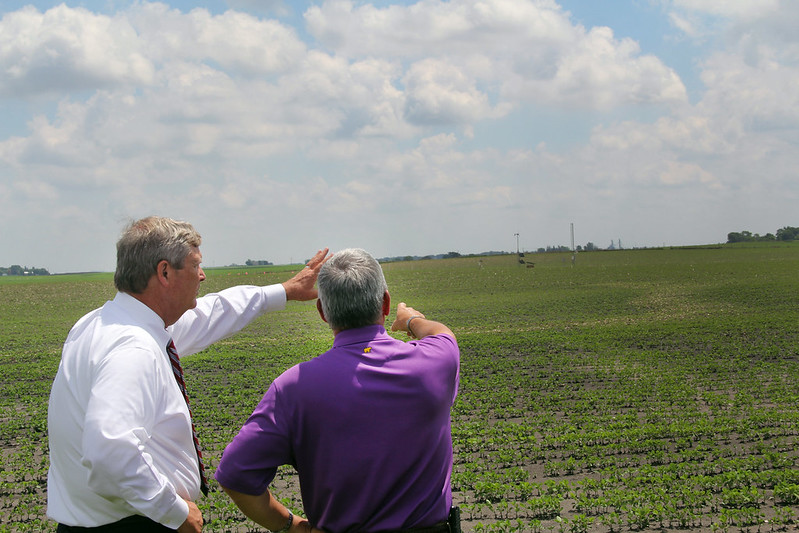Optimizing Agricultural Management to Mitigate Climate Change Impacts
ARS climate change research builds the science-based foundations for mitigating greenhouse gas. ARS climate change research focuses on adaptation and mitigation. Adaptation investigates how to make plant and animal ecosystems more resilient to predicted climate changes and weather extremes. Mitigation develops practices and technologies that reduce fossil fuel use and greenhouse gas (GHG) emissions, sequester carbon, and generate feedstocks or energy to offset fossil fuel use. ARS research provides critical measurement and model simulation data about GHG emissions from different land uses and activities for the U.S. National GHG Inventory and other international inventories. The following accomplishments in 2021 highlight ARS advances in developing new management approaches and decision support tools to reduce agriculture’s carbon footprint and boost regional farmer incomes.
Steam-flaked corn and high-quality hay lower greenhouse gas emissions from cattle. Methane, nitrous oxide, and carbon dioxide are GHG that contribute to climate change. When added together, the global warming effects of these three gases make up the carbon footprint. ARS scientists in Bushland, Texas; Woodward, Oklahoma; El Reno, Oklahoma; and university and NGO partners studied how dietary ingredients affect the carbon footprint of cattle. GHG emissions were lower when cattle consumed a diet based on high quality hay. They found corn, a typical feedlot diet ingredient, is usually processed either by dry rolling or steam flaking before being fed. Feeding the cattle steam flaked corn reduced the carbon footprint by 9 to 13 percent. Steam flaked corn also reduced enteric methane emissions by 30 percent. These results show diet manipulation can be an effective method for reducing GHG emissions from cattle; high quality grass and steam flaked corn are two feed management practices immediately available to producers.
Climate change reduces frost exposure for high-value California orchard crops. Yearly frost damage can cause hundreds of millions of dollars in lost crop revenue to high-value perennials in California alone. ARS researchers in Davis, California, and collaborators with the USDA California Climate Hub used climate models to predict how the future shift of frost would affect a variety of perennials. They found that frost exposure is expected to decline by 63 percent by the mid-21st century. The results suggest that the majority of almond and orange acreage will see approximately 50–75 percent reduction in frost exposure by mid-century, with avocado acreage expected to experience more than 75 percent fewer frost hours. Irrigation is the most common means of mitigating damage, but is costly and energy intensive, and draws on limited water resources. The reduction in frost exposure means that water use and energy costs can also be reduced, and growers in the highest acreage counties may save more than 50,000 acre-feet of water and $4.2 million in electricity costs for water pumping per year, collectively—a significant benefit to the industry.
Climate change may exacerbate the threat of biological invasions by introduced bee species. Island ecosystems may be particularly sensitive to the combined effects of climate change and biological invasions. In Hawaii, there are 21 non-native bees that have the capacity to spread pathogens and compete for resources with some 60 native bees to Hawaii. ARS researchers in Logan, Utah, modeled the predicted distributions for eight non-native bee species in Hawaii across the islands under current and future predicted climate conditions. Although the models predict expansion of the invasive bees into higher elevations under 2070 climate scenarios, areas below 500 meters in elevation were predicted to maintain their species richness. These models have the capacity to inform management decisions by federal and state stakeholders for non-native bees in Hawaii by assessing risk of invasion into new areas around the archipelago.
Winter rye cover crop reduces nitrogen loss to drainage under climate change. Hypoxia or dead zones in coastal oceans have been expanding since the 1960s and are expected to increase with climate change if nitrogen (N) reduction strategies are not implemented. Implementing a winter rye cover crop (CC) into agricultural systems is one of the more promising strategies to reduce N loads to subsurface drainage without reducing cash crop production, but its effectiveness in the Mississippi River Basin (MRB) under expected climate change is uncertain. ARS scientists in Ames, Iowa, and El Reno, Oklahoma, used the field-tested Root Zone Water Quality Model (RZWQM) to produce simulations that suggest implementing winter rye CC in a typical Upper Midwest cropping rotation effectively addresses current goals of reducing future N load in field drainage in a northern MRB agricultural system without affecting cash crop production. This research will help in designing effective management systems to reduce hypoxia in the Gulf of Mexico and reduce N export to the MRB.
 Leach, Darin. Agriculture Secretary Tom Vilsack listens to U.S. Department of Agriculture (USDA) Agricultural Research Service (ARS) supervisory plant physiologist Dr. Jerry Hatfield explain the equipment to gather information on climate changes and impacts on corn and soybean plants in Iowa on Jun. 6, 2014. USDA photo. https://flic.kr/p/nWPMYF
Leach, Darin. Agriculture Secretary Tom Vilsack listens to U.S. Department of Agriculture (USDA) Agricultural Research Service (ARS) supervisory plant physiologist Dr. Jerry Hatfield explain the equipment to gather information on climate changes and impacts on corn and soybean plants in Iowa on Jun. 6, 2014. USDA photo. https://flic.kr/p/nWPMYF

